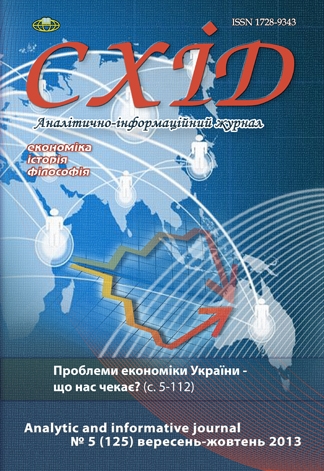Methods for evaluating efficiency of investment projects implemented on the basis of public-private partnerships in the housing and communal infrastructure
DOI:
https://doi.org/10.21847/1728-9343.2013.5(125).17758Keywords:
investments, public-private partnership, economic efficiency, housing and communal infrastructureAbstract
In the article the essence of the public- private partnership is defined; on the basis of the experience of European countries priority areas for the implementation of PPP projects are identified. They are transport and utilities infrastructure.
Generalized approach to evaluating the effectiveness of investment projects help to highlight two areas: economic and social efficiency. The indexes of social efficiency of PPP projects and efficiency indicators for projects of public and private partners and services consumer are defined.
The main stages of the analysis of public- private partnerships are defined. Key factors in choosing the best investment proposal are the minimization of utility rates, terms and government involvement in the financing of projects.
Economic evaluation of PPP projects is based on an analysis of four major factors: profitability index, net present value, internal rate of return, discounted payback period.
Assessing the economic efficiency of PPP projects take into account the index of riskiness of the project is proposed. This index is calculated by determining the list of major risks for the private partner, dividing them into groups by priority, assessing the probability of occurrence of each event using the method of expert estimates, the calculation point scoring system for the project. The resulting score is a general indicator of the riskiness of the project. This index allows to estimate the minimum possible economic benefit to which an investor can expect a high probability of a specified list of risks.
Downloads
References
Бубко О. П. Державно-приватні партнерства в Україні та перспективи їх впровадження на прикладі підготовки до Євро-2012 / О. П. Бубко // Науковий вісник Львівського державного університету внутрішніх справ. - 2011. - № 1. - С. 247-282.
Щодо розвитку державно-приватного партнерства як механізму активізації інвестиційної діяльності в Україні: аналітична записка [Електронний ресурс] / Національний інститут стратегічних досліджень при Президентові України. - Режим доступу : http://www.niss.gov.ua/articles/816/.
Хобта В. М. Оптимізація капіталовкладень на основі інтегральної оцінки ефективності інвестицій [Електронний ресурс] / В. М. Хобта, Ю. Ю. Бондаренко // Вісник Східноукраїнського національного університету імені Володимира Даля. - 2012. - № 11, ч. 1. - Режим доступу : http://archive.nbuv.gov.ua/portal/Soc_Gum/VSUNU/2012_11_1/Chobta.pdf.
Бондар Н. М. Оцінювання соціальної ефективності проектів державно-приватного партнерства / Н. М. Боднар // Вісник Національного транспортного університету. - 2012. - № 10. - С. 374-379.
Методика проведення аналізу ефективності здійснення державно-приватного партнерства [Електронний ресурс] : за даними Міністерства економічного розвитку і торгівлі України. - Режим доступу : http://zakon2.rada.gov.ua/laws/show/z0399-12.
Методика виявлення ризиків, пов'язаних з державно-приватним партнерством, їх оцінки та визначення форми управління ними [Електронний ресурс] : за даними Кабінету Міністрів України. - Режим доступу : http://zakon4.rada.gov.ua/laws/show/232-2011-%D0%BF.
Прибыткова Г. В. Анализ и оценка рисков предприятий производственной сферы в процессе инвестиционного проектирования / Г. В. Прибыткова // Вестник МГТУ. - 2005. - № 2, т. 8. - С. 300-305.
Полуянов В. П. Концессии в теплоснабжении и водоснабжении: за и против / В. П. Полуянов, Е. И. Полуянова // Вестник экономической науки Украины. - 2013. - № 1. - С. 137-146.
REFERENCES
Bubko O. P. (2011), Public-private partnership in Ukraine and prospects for implementation as an example of preparation for Euro 2012, Scientific Bulletin of the Lviv State University of Internal Affairs, 1, pp. 247-282 (ukr).
National Institute for Strategic Studies under the President of Ukraine (2012), On the development of public-private partnerships as a mechanism to stimulate investment in Ukraine, available at: http://www.niss.gov.ua/articles/816/ (ukr).
Khobta V. M., Bondarenko Yu. Yu. (2012), Bulletin of the East Ukrainian Volodymyr Dahl National University, № 11, available at: http://archive.nbuv.gov.ua/portal/Soc_Gum/VSUNU/2012_11_1/Chobta.pdf. (ukr).
Bondar N. M. (2012), Evaluation of social effectiveness of public-private partnerships, Bulletin of the National Transport University, № 10, pp. 374-379 (ukr).
Ministry of Economic Development and Trade of Ukraine (2012), Methods of analyzing the effectiveness of the implementation of public-private partnerships, available at: http://zakon2.rada.gov.ua/laws/show/z0399-12 (ukr).
Cabinet of Ministers of Ukraine (2011), Methods of identifying the risks associated with public-private partnership, their assessment and determining the form of management, available at: http://zakon4.rada.gov.ua/laws/show/232-2011-%D0%BF (ukr).
Pribytkova G. V. (2005), Analysis and risk assessment of industrial enterprises in the sphere of investment planning, Vestnik MGTU, 2, pp. 300-305 (rus).
Poluyanov V. P., Poluyanova Ye. I. (2013), Concession in heating and water supply: Pros and Cons, The Journal of Ukraine Economic Sciences, 1, pp. 137-146 (rus).
Downloads
Published
How to Cite
Issue
Section
License
Copyright (c) 2013 Volodymyr Poluyanov, Maryna Holovchanska

This work is licensed under a Creative Commons Attribution-NonCommercial-NoDerivatives 4.0 International License.
1. Authors bear responsibility for the accuracy of facts, quotations, numbers and names used.
2. Manuscripts are not sent back.
3. The publisher does not always agree with the authors' opinion.
4. The authors reserve the right to authorship of the work and pass the first publication right of this work to the journal under the terms of a Creative Commons Attribution-NonCommercial-NoDerivatives 4.0 International License. This license allows others to distribute (copy) the published work for non-commercial purposes, provided there is mandatory attribution to its authors and a link to the first publication in our journal.
5. The authors have the right to conclude separate supplement agreements that relate to non-exclusive work distribution in the form in which it has been published by the journal (for example, to upload the work to the online storage of the journal or publish it as part of a monograph), provided that the reference to the first publication of the work in this journal is included.

